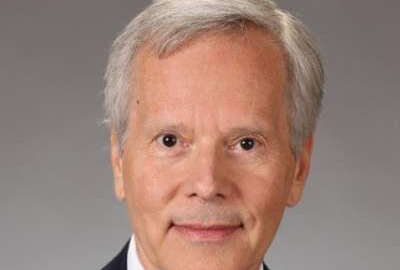
Who gets to manage traffic in space?
Which federal agency should take charge of space traffic management? Congress couldn't figure that one out. So it hired the National Academy of Public...
Best listening experience is on Chrome, Firefox or Safari. Subscribe to Federal Drive’s daily audio interviews on Apple Podcasts or PodcastOne.
Yogi Berra would have gotten it wrong when it comes to the space surrounding Earth. It’s gotten so popular people are still flocking there. It raises serious questions: Which federal agency should take charge of space traffic management? Congress couldn’t figure that one out. So it hired the National Academy of Public Administration. For what NAPA concluded, Federal Drive with Tom Temin turned to study fellow and former NASA Administrator Sean O’Keefe.
Interview transcript:
Tom Temin: Sean, it’s been a while but it’s good to have you back.
Sean O’Keefe: Well, thanks Tom, nice to be with you as well.
Tom Temin: And let’s start with the scope of this study. I mean, what were you trying to find out here? Because there were four agencies, I guess, in contention for designation as the main traffic controller for space.
Sean O’Keefe: Well, I think that’s one way to look at it. It’s more a circumstance of someone has to take charge, as it were, of the full range of space situational awareness, and some semblance of management of objects that are being launched in the space. The market is picking up so dramatically, that is getting to be pretty crowded up there. So the opportunity to avoid collisions, debris damage – name any number of factors [that] can go into this – is really getting pretty precarious at this point. So trying to figure out what is the best organization within the federal expanse, to coordinate to integrate all the capability the federal government has across the board was the mission we were handed.
Tom Temin: And we talking about low Earth orbit, high Earth orbit or everything in between?
Sean O’Keefe: Very dominantly low Earth orbit. Think you know, 225 to 300 miles off the surface of the earth. That is the sweet spot, if you will, for where an awful lot of satellites and other space objects typically navigate because it’s optimum kind of conditioning from gravitational position of the earth as well as just the physics of what, and orbital mechanics of what make it work so well.
Tom Temin: Sure, and is there DoD assets there as well as civilian and weather and so on?
Sean O’Keefe: Yes, lots of different international participants that are there as well. Not too many years ago, a couple decades back, there was basically two dominant players who got to space. Now it’s at least a half a dozen and growing.
Tom Temin: Plus the commercial aspect.
Sean O’Keefe: Yeah, well, nation states that have the capacity to do so then in turn the commercial folks who are expanding who then use that infrastructure in order to access, yes.
Tom Temin: And actually, let’s get to the conclusion of the report: Who should be the lead agency here?
Sean O’Keefe: The best coordinator with the greatest reach to all the constituencies and that has the capacity, at least at its foundational level right now, is the Department of Commerce and its Office of Space Commerce. So there’s a strong motivation on the part of the industry to really understand the precision of exactly what’s up there, where should they be operating, and how to go about doing so in, or risk-assured leads to do so to mitigate that. So that has all the motivation in the world to really gravitate to the Commerce Department for that role. Plus, they have the reach to the State Department, the Defense Department, the FAA, NASA, and within their own National Oceanographic and Atmospheric Administration – NOAA capacity that’s there too. So they’ve got a pretty good connectivity with all those different enterprises on a regular basis.
Tom Temin: And just briefly, what was the methodology that the study group for NAPA used to come to that conclusion?
Sean O’Keefe: Well, we weighted four agencies – Commerce’s Office of Space Commerce, the NASA enterprise, the Department of Defense, and the FAA – all four of which have had some engagement, if you will, in space situational awareness, as well as space traffic management to some degree or another. And so evaluating their capabilities, their willingness, their interest in engaging on this particular case, their capacity to interact with those emerging commercial partners, all the other factors that went into this, we weighted all that on a valued scale. And the Commerce Department’s option came up most favorably.
Tom Temin: We’re speaking with Sean O’Keefe, the former administrator of NASA and study fellow now for the National Academy of Public Administration. And just what are some of the challenges? There’s a lot of objects up there, I think most people would conclude that because they’re orbiting, they’re moving at the same direction and the same speed. So what are some of the issues that need to be managed in space and then we’ll get into how you do that.
Sean O’Keefe: The precision of awareness where they are. Right now it’s okay. But it’s – “okay” it’s not okay ,in this particular circumstance, when you’re dealing with a very expensive and, in some cases like the International Space Station, people aboard. So that’s gonna change as well. Or you get into space tourism that’s being promoted by some companies, all kinds of things. This becomes a rather hazardous wild west kind of atmosphere that’s growing. Because as you mentioned up front, the number of companies that are engaging now and getting into launching a wide array of satellite constellations, if you will, is now projected to be looking in the range of at least 1,100 per year new objects being launched to space. And right now we’ve got kind of a wide band precision of figuring out exactly where some of those objects are actually orbiting, that is wider than it should be. It needs to be a much greater level of precision, to understand where it is. And you’re right. Everything travels at roughly 17,500 miles an hour just by virtue of the condition of where the operations take place that it does vary based on size and so forth. But it nonetheless is in that general span, but not having an idea of exactly where something is with the accuracy of what we’d see, for example, in civil aviation transportation around the Earth, right now. So there’s a plane up there somewhere over off to the right, just watch out for it – no, that’s a level of precision that would be too precarious for anybody to engage with. Probably the best analogy is to think more of a maritime kind of analog, of having an awareness of where different shipping lanes are, who’s in that shipping lane now. And the amount of time it takes it actually to adjust the maneuvering of a ship is roughly comparable to the amount of time it would take in order to have any influence over changing the general direction of a space asset. It is a really hard procedure.
Tom Temin: But that raises a lot of questions because, one, everything up there would have to have the ability to broadcast and state where it is. And then it would also have the ability to be maneuvered, I would think, and do they all have that – those capabilities? And who would decide who moves where? Is that something that you envision the Commerce Department doing, or simply being an advisory and telling SpaceX that your satellite’s about to bump into XYZ from China, and you guys figure it out?
Sean O’Keefe: Very much the latter. This becomes a, “Your call. If you want to stay on that path, it’s up to you, you do it.” It’s the idea of trying to be a international controller of assets up there is just going to be a long shot. I mean, this is got to be a coalition of not just the willing, it’s going to be a coalition of those with a self interest to avoid problems here. And that’s a pretty powerful motivator all by itself. You know, the theory is that ought to work its way through and if we waited around to try to get consensus on an international scale, this would probably be a very long wait, because it just takes that much time to pass through all the wickets to accomplish that. Instead, let’s base this on the proposition that there’s a motivation on the part of nation states as well as individual commercial firms to avoid the disasters that otherwise would routinely happen.
Tom Temin: And is the expectation that the nations that own and operate assets in space and the companies that do – any organization – would then be willing to subscribe to the data that is put up basically, it would be a data service, that sounds like, and that’s pretty much self interest – they would say, why not listen to what they’re telling us?
Sean O’Keefe: That’s not a bad way of looking at it. It also is one where there really needs to be some interaction with all those constituencies to make them more aware of how to access this and which information capacities are going to be of the greatest precision. You still have to coordinate the launch and re-entry dates for everything. So the FAA is going to continue to have a very instrumental role in that regard to assure safeguard of the civil transportation in the airspace around the Earth right now. So all those different coordination factors and integration of assets and capabilities, and having a direct relationship with each of the individual players who want to operate there, either nationally or through commercial interest is going to be the real trick that they have.
Tom Temin: And unrelated, as a former NASA administrator, former US budget official, former many job holder, you must have been excited when earlier this year, NASA contracted the ability to launch people into space again from the United States. Bring them back safely. Commercial contractor – a lot of new things, a lot of old-looking things but that must have been quite a sight.
Sean O’Keefe: It’s a great achievement, and it’s one that is a testimony to a lot of hard work I mean, the whole strategy layout approach of trying to turn over routine and regular transit back to the International Space Station for crew, return cargo capabilities on the station, logistics, resupply and so forth – the whole strategy that was laid out 15 years ago, and the initial efforts to really get that underway or launched in earnest, a decade ago. So it takes time for all those things to come to be. And so much of what the commercial companies have done have evolved over that span. But now we’re in a position to take advantage of that, on a very direct way to have the, again, those routine resupply kinds of missions, be accommodated by commercial interests. That’s what they do best always. And that frees up NASA for the exploration objectives that it was founded for. And that’s what they’re after. They’re looking at Artemis and all these other programs for going beyond this, that now, gets them out of the one-over-one routine, operations kind of things or into the activity of deep space exploration and rescue.
Tom Temin: Sean O’Keefe is former administrator of NASA and study fellow for the National Academy of Public Administration. Thanks so much for joining me.
Sean O’Keefe: Thanks, Tom. Pleasure to be with you as always.
Tom Temin: We’ll post this interview along with the NAPA findings at www.FederalNewsNetwork.com/FederalDrive. Launch the Federal Drive on your schedule. Subscribe at Apple Podcasts or Podcastone.
Copyright © 2024 Federal News Network. All rights reserved. This website is not intended for users located within the European Economic Area.
Tom Temin is host of the Federal Drive and has been providing insight on federal technology and management issues for more than 30 years.
Follow @tteminWFED
Related Stories





